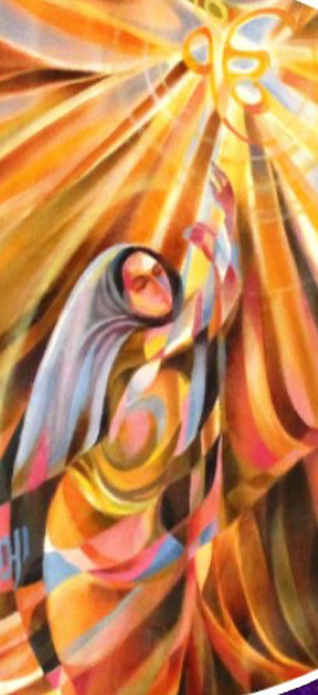Art
(Mis)Interpretation: Sikh Feminisms In Representations, Texts & Lived Realities:
A Sikh Feminist Ethnographic Exhibit
SATWINDER KAUR BAINS
University Of The Fraser Valley
Abbotsford, British Columbia, Canada
September 29 – October 30, 2015
A critical Sikh feminist ethnographic exhibition curated by the Centre for Indo Canadian Studies at the University of The Fraser Valley, in partnership with the Visual Arts Department and the International Department, opens on September
29 at 5 pm at the S'eliyemetaxwtexw Art Gallery, Building B, Room 136, Abbotsford campus.
The exhibit is entitled - (Mis)Interpretation: Sikh Feminisms in Representations, Texts and Lived Realities.
The goal of this exhibit is to de-centre the notion of a normatively androcentric faith discourse and to (re)raise the textual and practical meaning of Sikh feminist thought and understanding.
The exhibit looks at how the Sikh spiritual text, Guru Granth Sahib, is to be understood and interpreted individually by all practicing Sikhs, guided by the rehat maryada, historical texts, various interpretations, contemporary views and
personal sense-making (via spiritual learning and lived realities).
As well, in this exhibit Sikh women see themselves not just as interlocutors but as vital meaning makers of the Faith, its various interpretations and its inherent impact on their lives by way of the 5 Kakkaar’s – Sikh articles of faith -- where the
ethical Khalsa is imbued with gender neutral/supportive personal agency.
As well, Sikh women’s daily engagement and access to the living world is explored through photographs taken by eight Sikh women. The meaning of Ikk Oan Kaar and its universal appeal is reconnoitered and the textual interpretation of Guru Granth Sahib through a female lens is surveyed.
Leading feminist scholar Dr. Nikky Guninder Kaur Singh of Colby College, USA will give the keynote speech, bringing voice, praxis, understanding and sense-making.
The daily representation of a disaporic reality that is feminine consciousness personified is explored through a short documentary.
The social, cultural and religious world come together in an interactive component that allow Sikhs, visitors and guests to provide suggestions through their own lens and understanding. The Baarah Maah (The Twelve Months) provides the textual context of various spiritual verse translations that are available for viewers to respond with their comments on the translations (four in all).
The exhibit represents Sikh women’s lives through photographs of their lived realities in a way that reflects Sikhi ways of doing and knowing. As an ethnographic story of Sikh women unfolds through pictures, we see ourselves, and those others around us, those who informs our thoughts, our ideas and our beliefs (like Guru Granth Sahib / our families / our community), our proud tradition as sevadarnis, as keepers of the faith, as women who share our past and our traditions with our children, our families and the next generation while valuing what the older generations of women have given us as their legacy.
For more information please contact Satwinder.bains@ufv.ca
Satwinder Kaur Bains is the Director of the Centre for Indo Canadian Studies at The University of the Fraser Valley.
September 15, 2015
Conversation about this article
1: Sharanjit Kaur Sandhra (Abbotsford, British Columbia, Canada), September 16, 2015, 7:41 PM.
How exciting .... this sort of dialogue is SO needed. And the exhibit form will bring in younger generation Sikh youth to engage with Sikhi on a new level. I am very much looking forward to hearing Nikky speak.
2: Bhai Harbans Lal (Dallas, Texas, USA), September 17, 2015, 2:15 PM.
Very timely initiative, Satwinder ji. We wish you success. Feminine issues have long been neglected in our community. I am glad that your institution is taking such an initiative under your leadership. Others will follow. I am personally indebted to two Sikh women granthis who helped my parents raise me as a Sikh since the day I was born. I do not come across female Sikh granthis any more except those initiated by Singh Sahib Harbhajan Singh of 3HO.
3: Arjan Singh (USA), September 22, 2015, 11:52 PM.
I grew up as a son of an educated and career-oriented mother. She was a career teacher and founder of not one but two private schools in androcentric Indian Punjab. To say that she had to suffer countless embarrassments and harassment on many occasions in Punjab itself would be an understatement. She persevered and her talent was recognized by many. I cannot even waste my previous words on the rest of India, but suffice it to say that in the present day Punjab women have to face countless hurdles to create a career and follow their calling. That my mother did that in the tumultuous 1980s and 1990s is even more admirable. We must give respect and space to our women, else Amrita Pritam’s words in her poem "Today I say to Waris Shah" for the woman who were abused shamelessly during the Partition of Punjab in 1947 shall go waste.





